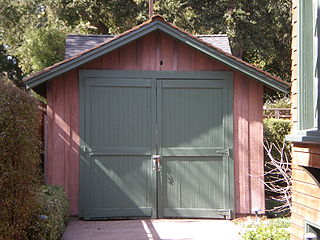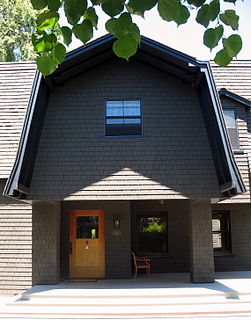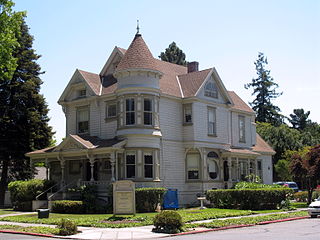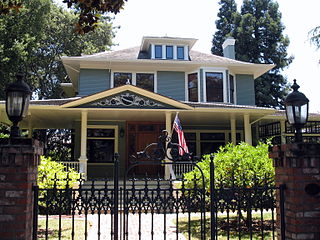
Bernard Ralph Maybeck was an American architect in the Arts and Crafts Movement of the early 20th century. He was an instructor at University of California, Berkeley. Most of his major buildings were in the San Francisco Bay Area.

The Rengstorff House was one of the first houses to be built in Mountain View, California. It was built c. 1867 by Henry Rengstorff, a prominent local businessman who operated a ferry between San Francisco and Mountain View. It is built in the Italianate Victorian architecture style. The house's three-bay front facade features an entrance pavilion topped by a balustrade and a pediment on the middle bay.

The HP Garage is a private museum where the company Hewlett-Packard (HP) was founded. It is located at 367 Addison Avenue in Palo Alto, California. It is considered to be the "Birthplace of Silicon Valley". In the 1930s, Stanford University and its Dean of Engineering Frederick Terman began encouraging faculty and graduates to stay in the area instead of leaving California, and develop a high-tech region. HP founders Bill Hewlett and David Packard are considered the first Stanford students who took Terman's advice.
Birge Malcolm Clark was an American architect, called “Palo Alto's best-loved architect” by the Palo Alto Weekly; he worked largely in the Spanish Colonial Revival style.

Palo Alto station is an intermodal transit center in Palo Alto, California. It is served by Caltrain regional rail service, SamTrans and Santa Clara VTA local bus service, Dumbarton Express regional bus service, the Stanford University Marguerite Shuttle, and several local shuttle services. Palo Alto is the second-busiest Caltrain station after San Francisco, averaging 7,764 weekday boardings by a 2018 count. The Caltrain station has two side platforms serving the two tracks of the Peninsula Subdivision and a nearby bus transfer plaza.

Professorville is a registered historic district in Palo Alto, California that contains homes that were built by Stanford University professors. The historic district is bounded by Kingsley and Addison avenues and the cross streets of Ramona and Waverley. The community considers the district to be larger and bounded by Addison and Cowper St. to the north west and north east and Emerson St. and Embarcadero Rd. to the south west and south east.

The Ramona Street Architectural District, in downtown Palo Alto, California, is a Registered Historic District. This portion of the street, between University Avenue and Hamilton Avenue, is a highly distinctive business block. It showcases the Spanish Colonial and Early California styles with gentle archways, wrought iron work, tile roofs of varying heights and courtyards.

Palo Alto Plantation is an historic mansion located at the corner of LA-1 and LA-944, along Bayou Lafourche in Donaldsonville in Ascension Parish, Louisiana. It was built in c.1847 and was added to the National Register of Historic Places on April 13, 1977. The architecture is an Anglo-Creole type Louisiana plantation cottage decorated in Greek Revival style.

The U.S. Post Office, located at 380 Hamilton Ave., is the main post office in Palo Alto, California. The U.S. Post Office was added to the National Register of Historic Places on April 5, 1981.

The T. B. Downing House is a historic house located at 706 Cowper St. in Palo Alto, California. The Queen Anne style house was built in 1894 for T. B. Downing, who served on Palo Alto's first city council. A conical tower tops the house's northern corner; the tower features a finial, a dentillated and bracketed cornice, and decorative shinglework. The porch features a decorated gable and gingerbread-style ornamentation along the roof, columns, and balustrade. Two other gables, one at the second floor and one at the attic, adorn the front of the house; both gables feature decorative bargeboards.

The Kee House is a historic house located at 2310 Yale St. in Palo Alto, California. Built in 1889, it is one of the oldest houses in Palo Alto and the oldest surviving building from Mayfield, a village that predated Palo Alto and was later annexed into the city. The house was one of the first built in the College Terrace tract, a middle-class residential area named for its proximity to Stanford University. The two-story house has an Italianate design with Eastlake elements. The front and side porches feature carved brackets and turned posts; the rear entrance originally had a similar porch. The hip roof features double brackets and a frieze below its eaves.

Palo Alto Plantation is a historic plantation house located at Palopato, Onslow County, North Carolina. It was built between about 1836 and 1840, and is a two-story, five bay, double-pile frame dwelling with vernacular Federal and Greek Revival style design elements. It has a gable roof with cupola, two-tiered engaged porch, and Palladian windows on the gable ends. It was the childhood home of Daniel L. Russell, Jr. (1845-1908), governor of North Carolina, 1897–1901.

The Theophilus Allen House is a historic house in Palo Alto, California, U.S.. It was built in 1905 for Theophilus Allen, the founder of the Palo Alto Christian Science Church. It was designed in the American Craftsman style by architect Alfred W. Smith. It has been listed on the National Register of Historic Places since May 20, 1999.

The Pedro de Lemos House, also known as Hacienda de Lemos and Waverley Oaks, is a historic house in Palo Alto, California. It was built from 1931 to 1941 for Pedro Joseph de Lemos, a painter, printmaker, illustrator and architect. Lemos also served as the director of the Stanford University Museum of Art from 1918 to 1947. The approximately 9,000 square foot house was design and built by Lemos, from 1931 until 1941.

The Wilson House is a historic house in Palo Alto, California. It was built in 1906. It was designed in the Colonial Revival architectural style. It has been listed on the National Register of Historic Places since January 2, 1980. According to the NRHP: "Almost two stories in height, it is, in terms of size, shape and quality among the finest residential example of its era in Palo Alto. The design is complex, the colors striking, and the rounded forms dictated by the bay are both unusual and difficult to execute. The workmanship is particularly well done."

The John Adam Squire House is a historic house in Palo Alto, California. It was built in 1904-1905 for John Adam Squire, a Greek professor. Squire lived here with his wife Georgina and their three daughters until his death in 1930. His wife died in 1959.

The Fraternal Hall Building is a historic building in Palo Alto, California. It was built in 1898 for the Fraternal Hall Association. The founding members included Knights of Pythias and Freemasons. The association sold the building in 1925, and the second floor was home to the Elks Club.

The Hostess House is a historic house in Palo Alto, California. It was built in 1918 by the YWCA for members of the United States Army to meet their relatives while they were still serving in World War I. The Hostess House was originally located in Camp Fremont.

Palo Alto Medical Clinic, also known as the Roth Building was a former medical clinic. The building is located at 300 Homer street, at the corner of Bryant street in Palo Alto, California. It is listed on the National Register of Historic Places listings in Santa Clara County, California since 2010. The building is a good example of Spanish Colonial Revival architecture, and has historical relevance for the Palo Alto community, art history, and medical history.

Mrs. Clinton Walker House, also known as Cabin on the Rocks, is located on Scenic Drive in Carmel-by-the-Sea, California. The house was designed by Frank Lloyd Wright in 1948 and completed in 1951 for Mrs. Clinton Della Walker of Pebble Beach. It was listed on the National Register of Historic Places in 1977.




















